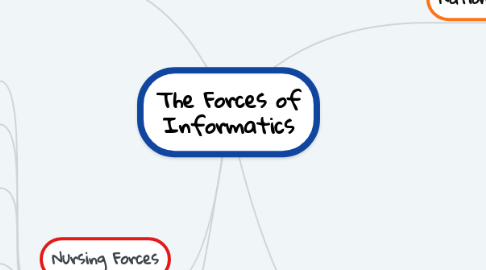
1. Nursing Forces
1.1. Dr. Harriet Werley
1.1.1. Insisted ANA make research about nursing informatics a priority
1.2. Gary Hales
1.2.1. Started the journal 'Computers in Nursing'
1.3. National Center for Nursing Research
1.3.1. Set six program goals for nursing informatics research regards to building clinical data bases and methods to evaluate nursing information systems
1.4. National Advisory Council on Nurse Education and Pratice
1.4.1. Wrote the 'National Informatics Agenda for Education and Practice'
1.5. National League for Nurses
1.5.1. Published a paper with recommendations for nurses to prepare for working with technology
1.6. American Nurse's Association
1.6.1. Published 'Standards of Practice for Nursing Informatics'
1.6.2. Published 'The Scope of Practice for Nursing Informatics'
1.7. Technology Informatics Guiding Educational Reform
1.7.1. Objective is to making nursing informatics competencies apart of nursing skillset
2. Consumer Forces
2.1. Increased availability and use of techonlogy
2.1.1. Smart phones, internet, E-Health
2.2. Consumer Empowerment
2.2.1. Advocate, active involvement
2.3. Desire for Engagement
2.4. Personal Health Record
3. External Forces
3.1. Environmental Characteristics
3.1.1. Political
3.1.2. Technological
3.1.3. Economic
4. National Forces
4.1. Institute of Medicene
4.1.1. Focuses on improving Health Care
4.1.2. Acts as adviser to the United Sates Government
4.2. President's Information Technology Committee
4.2.1. Creator of support for use of informatics
4.3. Office of the National Coordinator for Health Information Technology
4.3.1. Forefront of health information technology efforts
4.3.2. Focused on two goals: patient focused health and population health
4.4. Patient-Centered Health Care
4.4.1. Goal is to provide higher- quality, cost effective care using technology/electronic information exchange among health care provides and their patients
4.4.2. Nationwide adoption of use
4.5. Health Information Technology
4.5.1. Clinical Decision Support
4.5.2. Computerized Clinical Data
4.5.3. Internet
4.6. Affordable Care Act
5. Internal Forces
5.1. Organizational Structure
5.1.1. Hierarchy
5.1.2. Culture

